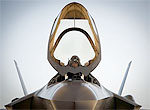Ship Trials Bring F-35B Capability, Operational Utility Into Focus
 FORT WORTH, Texas, September 19, 2013 – Recent ship trials for the Lockheed Martin [LMT] F-35B onboard the USS Wasp [LHD-1] underscored the fifth-generation fighter’s unique capabilities and operational utility according to Marines and sailors alike.
FORT WORTH, Texas, September 19, 2013 – Recent ship trials for the Lockheed Martin [LMT] F-35B onboard the USS Wasp [LHD-1] underscored the fifth-generation fighter’s unique capabilities and operational utility according to Marines and sailors alike.
In a video released today, U.S. Navy Capt. Erik Etz stated, “A fifth-generation aircraft, such as the F-35, will open up threat areas where previous legacy fighters that operate off L-class ships weren’t even invited to play. So, an F-35B operating from this type of ship really gives a joint war-fighting commander different options to affect change in the world wherever it is necessary.”
Marine Corps Capt. Mike Kingen, an F-35 test pilot, added, “Ship-borne capabilities are important for the F-35B because they are important for the Marine Corps. Having F-35B, having a stealth platform that’s organic to that unit will allow us to support the Marines…. The F-35 is going to allow future pilots to worry less about stick and rudder skills and more about executing the mission.”
“The fact that the Harrier was not fly by wire at all, there was nothing in between me and the flight controls,” said Marine Corps Maj. Michael Rountree, an F-35 test pilot. “So, I could do things in the Harrier that would very specifically get me killed if I did them incorrectly. Whereas in this airplane there is a level of protection between me and those flight control surfaces. So in a mission – you know up and away from the ship – that’s going to allow me more time to think about the tactical picture, thinking about how I’m going to support the Marines on the ground.”
During the 18-day long ship trials, two F-35Bs conducted a series of tests to determine the aircraft’s suitability for sea-based operations. The aircraft completed 95 vertical landings, 19 of which were conducted at night, and 94 short takeoffs. The ship trials, known as Developmental Test-II, were a key milestone on the Marine Corps’ path to Initial Operating Capability which is scheduled for 2015.